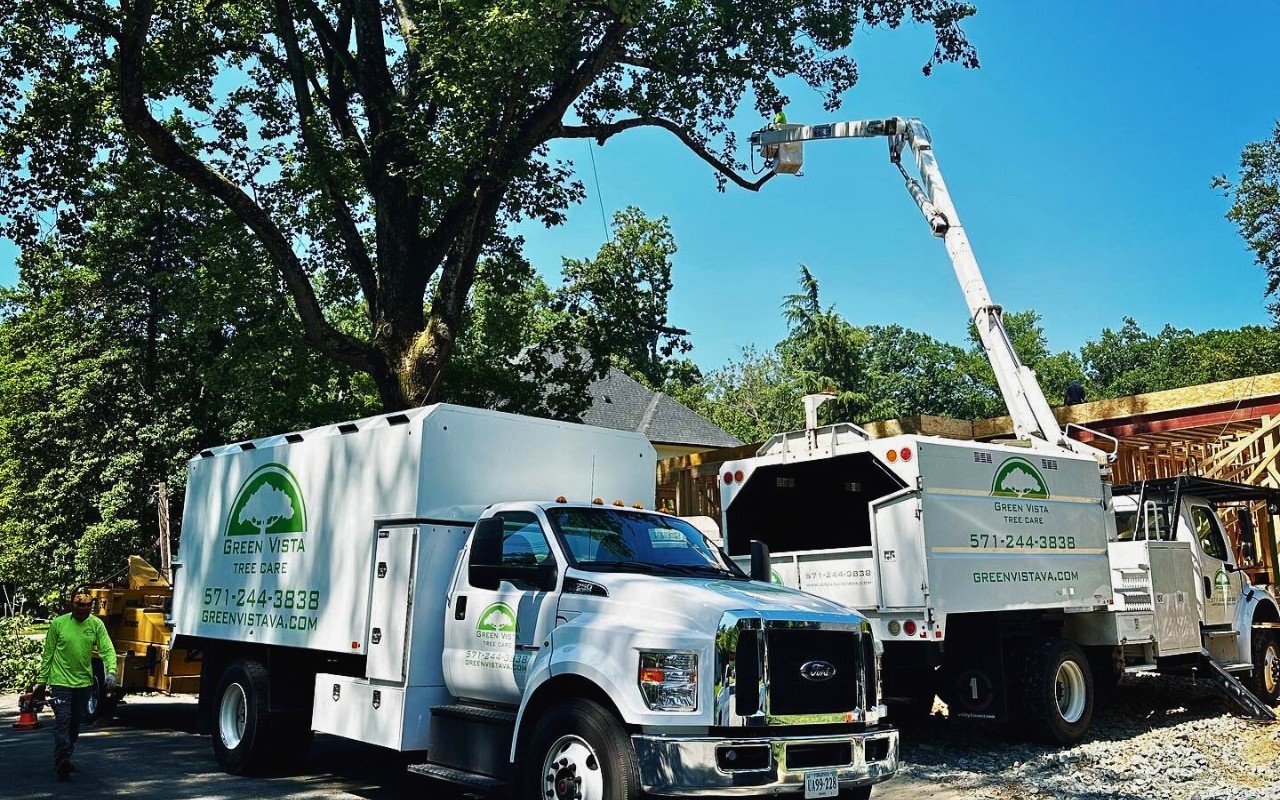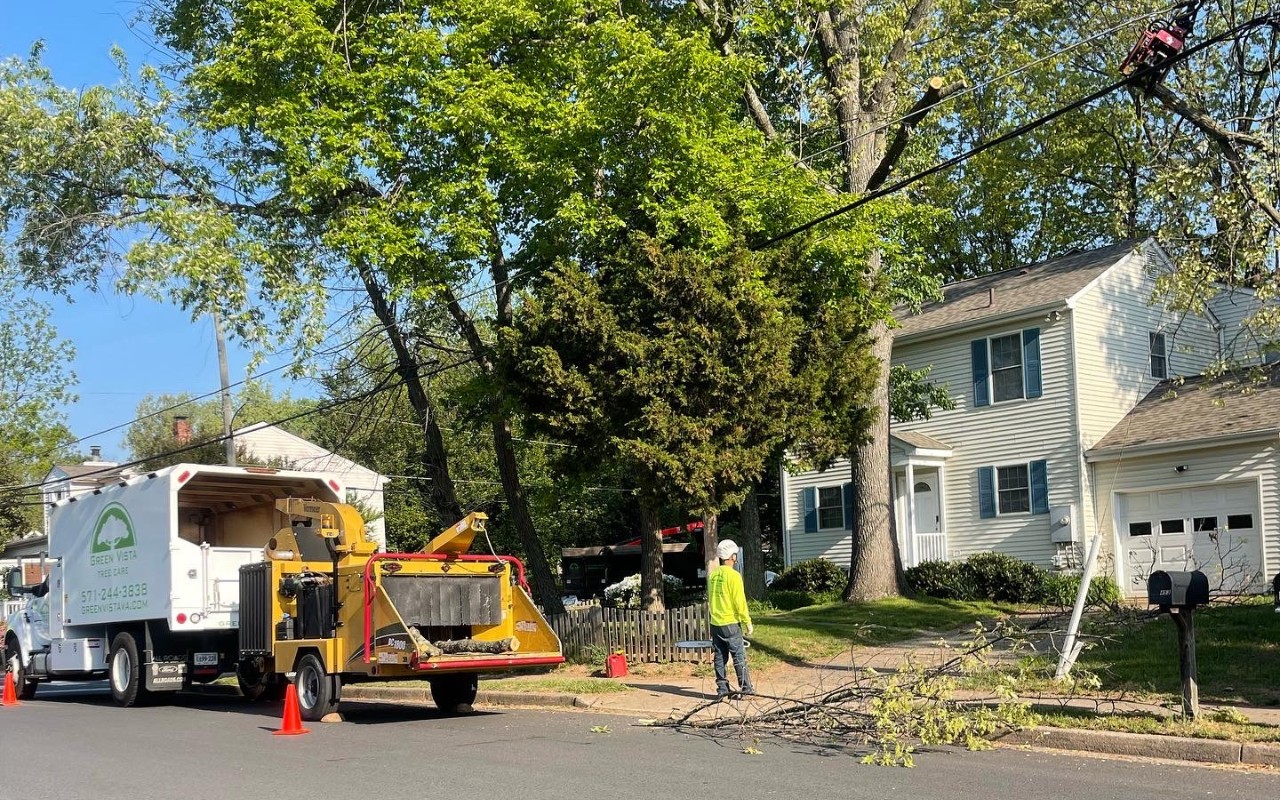Northern Virginia summers bring two major problems for your trees: heat stress and sudden storms. One dries them out, while the other can rip them apart. That combination makes it even more important to know when and how to prune – and when to leave your trees alone. Done right, summer pruning can reduce the risk of storm damage, improve structure, and take the pressure off already stressed trees.
Let’s walk through when summer pruning makes sense, when it doesn’t, and how to help your trees thrive in the toughest season of the year.
Key Takeaways
- Summer pruning should be light and targeted, focusing on shaping, removing dead or dying branches, and clearing structures rather than significant structural cuts.
- Dense canopies need summer thinning to improve air circulation, prevent mold development, eliminate competing branches, and enhance fruit production.
- Safety hazards are easier to spot in summer when dead, dying, or broken branches are more visible and branches growing into homes or power lines can be identified and addressed.
- Avoid pruning oaks and elms in summer because these species are vulnerable to diseases when pruned during warmer months.
- Professional pruning protects your trees and your property by avoiding the stress of overpruning and safely handling work near structures or power lines.
When and Why Summer Pruning Makes Sense
While summer isn’t the best time of year to do substantial trimming to your trees (winter is the best time for major pruning), there are still plenty of reasons to do it. Light pruning in the summer has numerous benefits for trees, and it allows you to address problems that would be difficult to spot in the winter, when trees are dormant.
Some of the goals of summer pruning are improving aesthetics, reducing canopy density, and making your tree safer.
WARNING: Overpruning in the summer is a common pruning mistake that can harm or kill your tree. When in doubt, have an expert arborist examine your tree and handle the pruning to avoid causing long-term harm.

Balancing Tree Shape and Size
In summer, your tree is fully leafed out, giving you the best view of its true shape and size – something you just can’t get in winter when the branches are bare. With the tree at its fullest, it’s easier to spot branches that throw off its balance or overcrowd the canopy.
Summer is the perfect time for light, selective cuts that enhance the tree’s appearance, while more aggressive structural pruning is best left for winter, when the tree is dormant.
Reducing Canopy Density for Better Light and Airflow
An overly dense canopy full of branches not only looks unkempt, but it also poses several health problems for your trees. It can be challenging to get an idea of how dense the canopy is during the winter, when there are no leaves on the tree, but it is definitely more apparent in the summer.
Some of the dangers of a crowded and dense canopy include:
- Competing Branches: Branches may begin competing for space in the tree to try to find light. When they do, they rub against each other, potentially damaging the bark. Losing the protection of the bark opens branches up to attacks from pests and diseases. If you notice two branches rubbing, have a professional remove one to protect the other from disease.
- Mold Development: A dense canopy won’t allow light penetration and air circulation. These are vital to preventing the development of a humid inner canopy, where mold and mildew can develop. Removing a few select branches can significantly decrease the humidity of the canopy and leave you with a healthier tree.
- Poor Fruit Production: Growing fruit trees is a popular choice in Northern Virginia, but it can be frustrating when they don’t produce the quality or quantity of fruit you expect. Thinning the canopy allows sunlight to reach more of the tree, which supports stronger growth and leads to better-quality fruit throughout the season.
PRO TIP: See our previous article for more information about when and how to do extensive fruit tree pruning in Northern Virginia.
Removing Dead, Diseased, or Broken Branches
Dead, diseased, or broken branches aren’t just eyesores on your tree; they can also be dangerous when a storm rolls through. These branches don’t have the same structural integrity to withstand storms as healthy live branches, making them more dangerous.
It’s easier to identify these branches when the tree is leafed out in the summer. Look for any branches that have no leaves on them or have extensive dead leaves.
Eliminating Branches That Grow into Structures or Utility Lines
Trees do not naturally grow in urban environments and landscapes. Because of this, they have no sense of space or concern for where they grow. They expand their canopy for more surface area to perform photosynthesis, which can lead to problems when they get too close to your home or begin to grow into utility lines.
In the summer, you’ll get the best idea of how close the branches and leaves have grown to your house or any nearby power lines. Ideally, they should be at least 10 feet from the roof, siding, and power lines. When they’ve grown too close, have a professional trim them.
This isn’t a job to handle yourself, as these pruning jobs can be hazardous. Tree trimming near power lines requires coordination with the utility company to shut down the power flow to protect the workers. And pruning near a house carries additional risks, as fallen branches can damage your roof. Handling this job requires extensive rigging and safety procedures.
Frequently Asked Questions About Summer Pruning
To help you better understand the importance and usefulness of summer pruning, we’ve answered some of the common questions homeowners have about it.
What trees should you avoid pruning in the summer?
While many trees can handle light summer pruning, some species are much more vulnerable and should be left alone until winter. Oaks, for example, are highly susceptible to diseases that contribute to oak decline, and pruning in warm weather increases the risk of infection. It’s best to wait until winter, when disease-carrying insects are inactive and pruning wounds are less likely to attract pathogens.
Elms are another tree to avoid pruning in summer. Cutting during the growing season can invite Dutch elm disease, a fast-moving fungal infection that can quickly kill even mature, healthy trees.
Why do we keep pruning light in the summer?
In the summer, tree pests and diseases are active and can harm your tree if you prune them too much. The open wounds take time and energy for your tree to compartmentalize and seal. During that time, pests and diseases may infiltrate the wound and infect or infest your tree. Keeping the pruning light gives them fewer avenues to attack your tree.
What are some tree species that benefit from summer pruning?
There are some trees that are actually best to prune during the summer. One type of tree we recommend pruning in the summer is “bleeders,” trees that produce a lot of sap after trimming. Some examples are:
- Birch
- Maples
- Walnuts
Additionally, summer is often a good time to prune evergreen trees.
Trees Looking Overgrown This Summer? Let Green Vista Do the Trimming
If your trees are looking wild, overgrown, or just plain messy, summer pruning might be exactly what they need. But doing it wrong or at the wrong time can stress or even damage your trees. That’s why it pays to have the Certified Arborists at Green Vista Tree Care handle the job.
Our team knows exactly what to cut, how much to remove, and when to leave a tree alone. With the right tools and expert techniques, we make precise cuts that promote faster healing and long-term health. Call us today at 571-244-3838 or request a quote online. Let’s get your trees back in shape – safely and professionally.
Get helpful tips, local news, inspiring stories, and more delivered right to your inbox every month. Don't miss another issue - join today!







